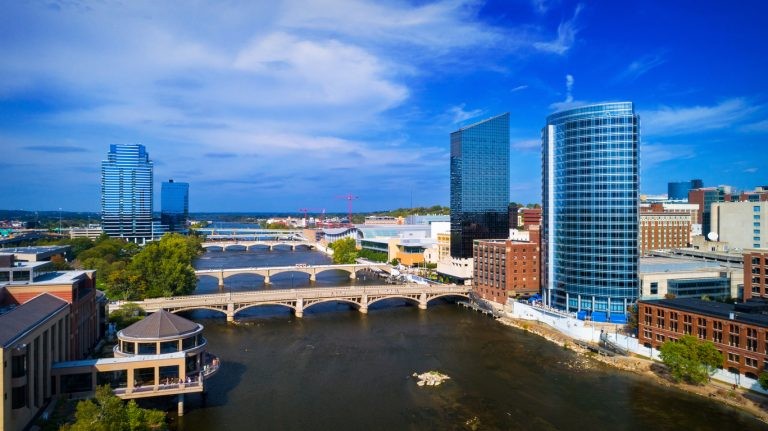
Kent County was named one of 11 U.S. counties that demonstrated a high level of resiliency in a new study from commercial real estate firm CBRE.
Counties were analyzed across a wide range of complex factors like modern health, weather, and economic disruptions that could factor into corporate expansion and relocation strategies.
Among the finalists, Kent County had an economic mix that was least dependent on the industries CBRE identified as potentially high risk in the environment. The concentration of these industries was roughly 22% lower in Kent County than the national average.
These industries include accommodation/food service, arts/entertainment/recreation, construction, real estate and retail.
In a region where population growth has largely stagnated, Kent County and its largest city of Grand Rapids defied the trend, growing widely and consistently. According to the U.S. Census Bureau, between 2015 and last year, 13 of the county’s 14 incorporated municipalities posted net population growth.
CBRE’s location incentives group identified the 11 counties, spanning Ada County in Boise, Idaho, to Greenville County in Greenville, South Carolina, after filtering all 3,142 U.S. counties through diverse criteria that define resilience.
The exercise demonstrated how modern site-selection analyses can sift through multiple, wide-ranging qualifiers, even including a county’s susceptibility to wildfires, to arrive at sometimes intriguing conclusions that can factor into a company’s location strategy.
CBRE’s methodology favored counties with diverse economies, proximity to major universities and airports, growing populations, fiscal stability and affordable home prices.
Certain counties were disadvantaged due to the nature of CBRE’s analysis. Those included counties with high population density due to COVID-19 concerns, heavy reliance on public transit, high home prices and foreclosure risk, and significant exposure to natural disasters including wildfires, hurricanes and potentially rising sea levels.
“It’s important to keep in mind what this analysis shows us and what it doesn’t,” said Tedd Carrison, senior financial analyst in CBRE’s location incentives group. “What this demonstrates is that you can analyze many locations against wide-ranging economic, education, environment, fiscal, transportation and health metrics. And the results don’t always point to the largest metropolitan centers.
“However, this doesn’t mean that these metrics are exhaustive or that these 11 counties are the new, preeminent job destinations. Site selection for companies is a highly specific and individualized process. Dense cities and coastal hubs always will be well-positioned job markets, often due to established talent bases, innovation networks, cultural amenities and other important considerations. But smaller markets may be increasingly appealing as we continue into the next decade, and they should not be overlooked as viable options for many companies and projects.”
CBRE’s most resilient counties from west to east
- Spokane County, Washington
- Ada County, Idaho
- Davis County, Utah
- Douglas County, Nebraska
- Johnson County, Kansas
- Polk County, Iowa
- Hamilton County, Indiana
- Kent County
- Franklin County, Ohio
- Greenville County, South Carolina



